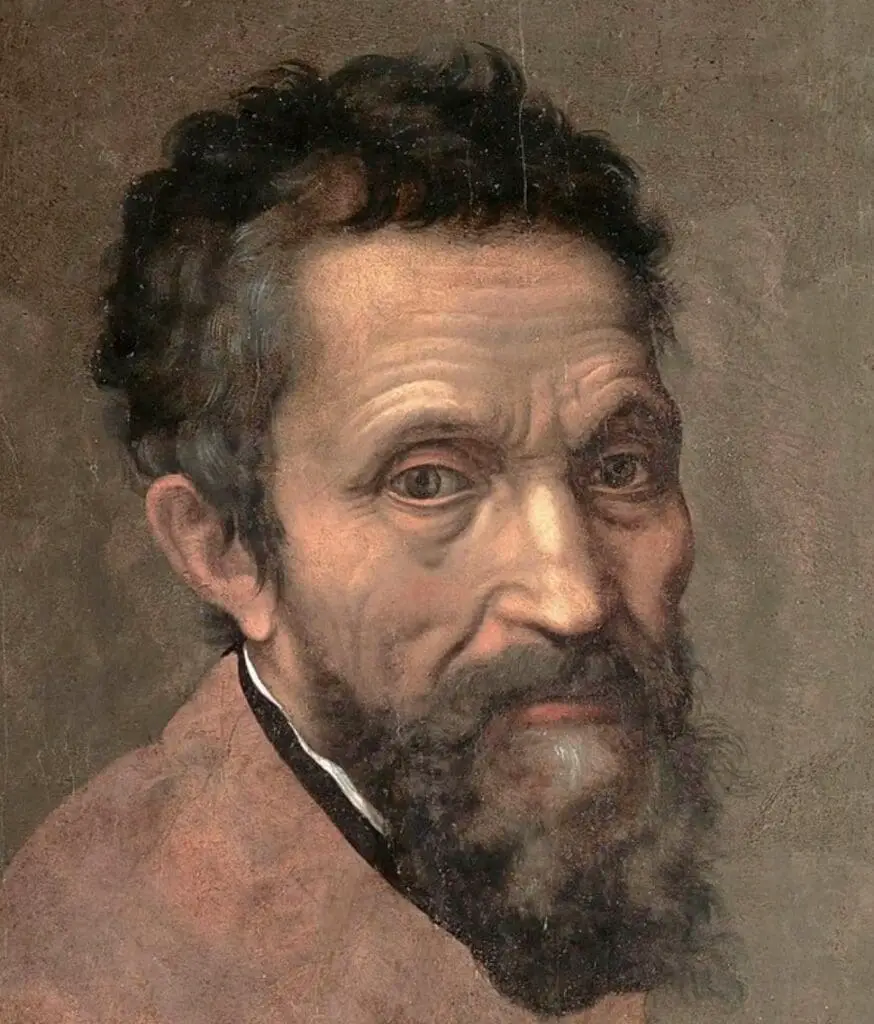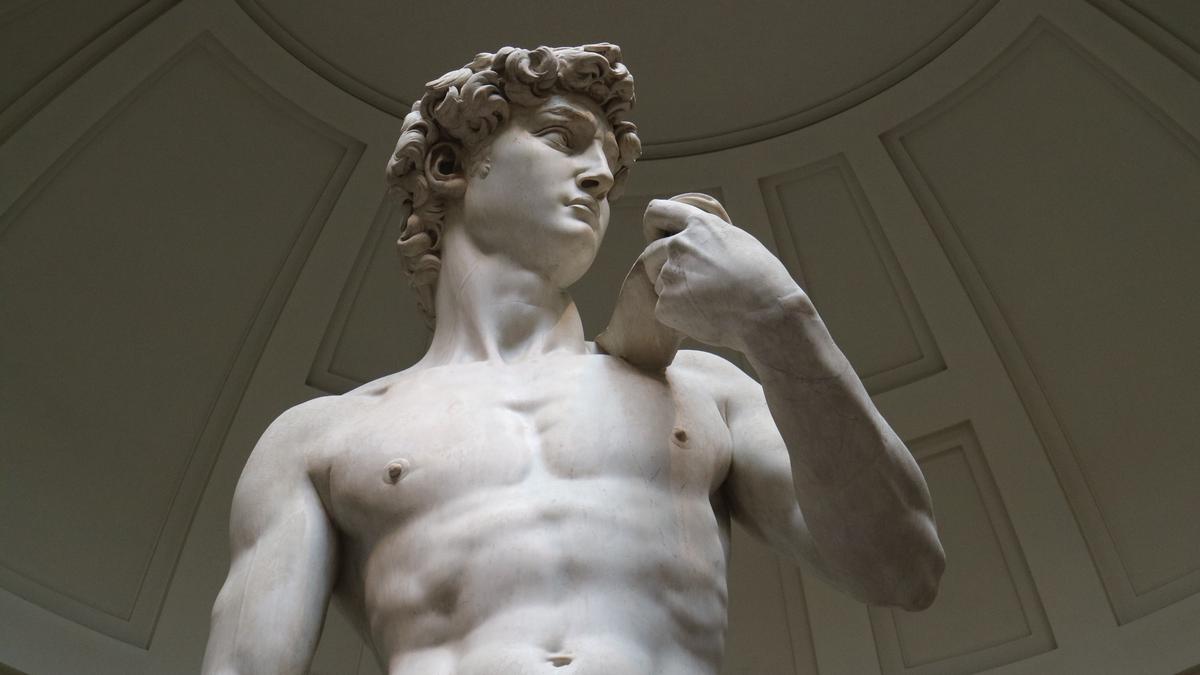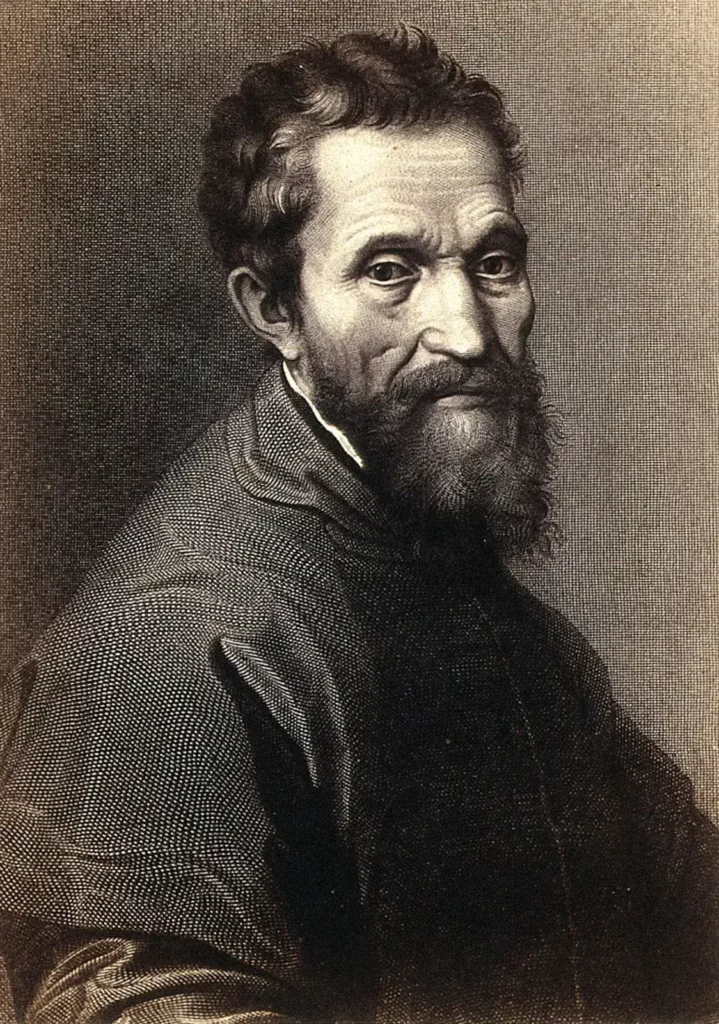Amidst the rich tapestry of Renaissance art, Michelangelo’s David is a towering testament to human potential and artistic mastery. Envisioned by the genius of Michelangelo at the dawn of the 16th century, this magnificent sculpture emerges not just as a biblical hero but as a symbol of the cultural reawakening that swept through Florence.
Embedded within the detailed contours of David’s form is the story of its creation—a chronicle that fuses its sculptor’s political, spiritual, and revolutionary innovations. As we embark on this exploration, we journey back to the flourishing realms of the Italian Renaissance to unearth the roots of this iconic masterpiece and follow Michelangelo’s footsteps as he transformed a solid block of marble into a timeless epitome of youth and courage.
Table of Contents
- The History and Creation of Michelangelo’s David
- Present Location and Past Movements
- Artistic Analysis of Michelangelo’s David
- Conservation Efforts and Challenges
- Related Questions
The History and Creation of Michelangelo’s David
Unveiling the Majesty of Michelangelo’s David: Historical Context and Artistic Significance
In the pantheon of artistic masterpieces, few sculptures command the reverence and acclaim of Michelangelo’s David. Indeed, this paragon of Renaissance sculpture is not only a testament to the artist’s incomparable prowess but also a mirror reflecting the turbulent socio-political environment of Florence during the early 1500s.
The story of David is not merely one of artistic endeavor; it is interwoven with the very fabric of Renaissance humanism and the shadow of civic strife.
To fully grasp the significance of David, one must journey back to the Republic of Florence at the dawn of the 16th century. At this time, Florence was a cradle of artistic innovation, a hub for thinkers and creators reviving classical antiquity’s ideals. Yet, the city-state was also navigating the choppy waters of political unrest.
Once benevolent patrons of the arts and de facto rulers of Florence, the Medici family were exiled, leaving behind a power vacuum and a republic asserting its independence and governance.
Enter Michelangelo Buonarroti, a sculptor of sublime talent, who, at the tender age of 26, was entrusted with a colossal block of Carrara marble. This marble, flawed and previously abandoned by other artists, was about to embody Florence’s indomitable spirit.
Michelangelo’s commission came from the Opera del Duomo, the cathedral’s workshop, and was intended to be one of a series of prophets to adorn the Florence Cathedral’s roofline. Yet, destiny had grander plans.
David stands 17 feet tall, a colossus towering over mere mortals, a deliberate reference to the heroic figures of antiquity. His posture embodies the contrapposto stance, his body twisting with a sense of dynamic potential, a hallmark of classical sculpture reborn in the Renaissance.
By depicting David before his battle with Goliath, with a furrowed brow and a concentrated gaze, Michelangelo captures a moment of intense psychological engagement, man’s inherent strength and intellect poignantly expressed.
But David is more than a biblical hero; he symbolizes the Florentine Republic—youthful, virtuous, and defiant despite overwhelming odds. As the young shepherd poised to confront the Philistine giant, David signifies the courage of the Florentines as they faced larger, more powerful states threatening their autonomy.
A public artwork, David was ultimately placed not in the cathedral but in the Piazza della Signoria, Florence’s political heart, further cementing its function as an emblem of civic pride and republican liberty.
Artistically, David marks a zenith in Renaissance sculpture. Staying true to the humanist pursuit of perfect proportions and naturalism, Michelangelo imbued the figure with breathtaking realism.
Veins and muscles are carved meticulously, evidencing an acute understanding of human anatomy. This attention to detail demonstrates the era’s fascination with studying the body, seen as a microcosm of the larger universe, a divine creation worthy of study and celebration.
Michelangelo’s David transcends its era, resonating as a beacon of human achievement through the ages. Its creation marked a bold statement during a time of sociopolitical upheaval, symbolized the triumph of intellect over brute force, and showcased the electrifying potential of the human form as an artistic subject.
As viewers stand beneath David’s looming figure, they not only gaze up at a masterpiece of Renaissance art but also a profound narrative forged in marble—a narrative of power, defiance, and the relentless pursuit of beauty inherent in the human spirit.

Present Location and Past Movements
Entwined with the rich tapestry of Florence’s past, Michelangelo’s David remains a beacon of Renaissance art that continues to captivate audiences with its storied legacy. From its inception to its current resting place, David has undergone a journey as monumental as its stature.
Upon its completion in the early 1500s, David originally stood in the Piazza della Signoria, Florence’s political heart. Here, the colossal statue transcended its role as an artistic marvel to become a political statement—a defiant challenge to all who sought to subjugate the Florentine people. Standing tall against tyranny, the figure was a constant reminder of Florence’s steadfastness in adversity.
After centuries in the piazza, concerns for preserving this Renaissance masterpiece prompted a move in 1873. David was transferred indoors to the Galleria dell’Accademia di Firenze, a veritable sanctuary for the arts where it could be protected from the ravages of weather and time. This significant relocation was spearheaded by art historians who recognized the need to shield the statue from potential deterioration and damage.
In the sheltered halls of the Accademia Gallery, David continues to inspire awe as the centerpiece of a collection dedicated to the genius of Michelangelo. Visitors flock from around the world to stand in the presence of this marble titan, immersed in the enduring narrative of Florentine pride and the exemplary craftsmanship that shaped it.
Over the years, preservation efforts have intensified to maintain the sculpture’s integrity. From limiting visitor numbers to implementing advanced conservation techniques, experts have meticulously ensured this iconic sculpture endures. Cutting-edge technology now aids in monitoring the condition of the marble, continuing a tradition of careful stewardship that will ensure David’s legacy persists for future generations.
David remains, without a doubt, a testament to the power of art to reflect and influence society. It symbolized the collective identity of a people during a pivotal historical moment and continues to serve as an emblem of the perpetual quest for political and artistic autonomy.
Encased within the walls of the Galleria dell’Accademia, the statue offers an ever-present connection to the grandeur of the Renaissance and the vibrant creativity that defined an era. It is a journey not merely through place but through time, as the heart of Florence preserves and venerates its most precious sentinel.

Artistic Analysis of Michelangelo’s David
The Artistic Genius Behind Michelangelo’s David: Sculpture Techniques and Enduring Impact
At the dawn of the 16th century, a masterpiece was meticulously carved from the hands of Michelangelo Buonarroti, an embodiment of artistic finesse and a beacon of human potential—the statue of David.
This magnificent work exemplifies Michelangelo’s unrivaled skill in bringing marble to life and continues to influence art and society today.
When studying Michelangelo’s methods in sculpting David, one is immediately taken by the audacious technique of contrapposto. With David’s weight resting on one leg, this dynamic position creates a sense of movement and tension. While not new, this technique was pushed to its limits by Michelangelo, capturing a moment of intense contemplation and readiness.
The sculptor’s deep knowledge of human anatomy is evident in the intricate representation of muscle, ligament, and bone—a testament to his lifelong research and studies of cadavers.
The chisel in Michelangelo’s hands worked as a tool and an extension of his intuitive grasp of three-dimensional form. His subtractive approach was akin to unveiling an existing figure within the marble, a philosophical reflection of his Neoplatonic beliefs. The intense detail observed in the curling locks of David’s hair and the intricate blood vessels snaking along his arms underscores Michelangelo’s intimate and profound connection with his medium.
Michelangelo’s David made a profound political statement standing in the Piazza della Signoria. It was a resounding beacon of Florentine freedom and defiance against all adversaries. The sheer scale of David, towering over the public space, turned the sculpture into a testament to civic pride and the power of the individual voice in shaping society.
Preservation of this iconic sculpture has been a relentless endeavor. Isolated from the deteriorating embrace of the elements, David now stands under the careful watch of dedicated custodians within the Galleria dell’Accademia di Firenze. Efforts have seen the implementation of state-of-the-art diagnostic tools and monitoring systems, ensuring the legacy of Michelangelo’s creation endures.
The commitment to uphold David’s structural integrity mirrors the enduring narrative of Florentine excellence in craftsmanship. From artisans to curators, the collective effort to maintain this sculptural titan is a modern reflection of the dedication of the Renaissance masters.
In integrating new-age technology with classical art, there is a powerful commentary on the role of innovation in protecting and understanding historical artifacts. Whether through non-invasive analysis or predictive conservation strategies, David’s ongoing care symbolizes a bridge between the old and the new.
The symbol of David, once a rallying cry for Republic ideals, has transcended its original context to inspire contemplations on autonomy, identity, and the universal quest for artistic and political expression. A paragon of the Renaissance spirit, David continues to stir the imagination, bringing to the forefront the limitless creativity and ambition that embodies the era.
Through the undying fame of David, Michelangelo’s work stands not merely as a representation of a biblical hero but as a powerful cultural and artistic touchstone, heralding the timelessness of human aspiration and the transformative power of art.

Conservation Efforts and Challenges
Michelangelo’s David stands not only as a testament to the virtuosic skill of its creator but also as an artifact that has endured the complexities of preservation across centuries. In safeguarding this quintessential emblem of the Renaissance, myriad strategies have been employed, each echoing the ever-evolving dialogue between past mastery and present innovation.
While the Florentine pride and the political narratives embedded in the stone of David have remained unyielding, nature’s elements have not been as kind to the marble titan.
After centuries in the Piazza della Signoria, David faced significant weathering, prompting concerns about its survival. The delicate intervention became imperative to halt the sculpture’s degradation, a challenge that initially involved sheltering the figure from the vicissitudes of the outdoors.
The relocation of David to the Galleria dell’Accademia di Firenze in the 19th century was a momentous transition in its conservation history. Inside this bastion of art and knowledge, David found respite from the climatic forces that once eroded its chiseled physique.
The controlled environment offered a stable haven, but the giant was not immune to the ravages of time even within these confines.
Amidst the recent rigors of conservation, there has been a noteworthy reliance on cutting-edge technology. High-resolution imaging, structural analysis using laser scans, and meticulous monitoring of stress fractures have all played a role in perpetuating the statue’s existence.
These scientific methodologies have become the new chisels and mallets, fine-tuning our approach to preserving the incomparable craftsmanship of Michelangelo.
Yet, the struggle to maintain the integrity of David extends beyond the remediation of physical stress. As a symbolization of Florence’s collective identity, the sculpture embodies an ongoing quest for political and cultural autonomy. Frozen in marble, its continual state of vigilance challenges conservators to be equally steadfast in their guardianship of this masterpiece.
As much as it is a product of its time, David also represents the enduring creative spark of the Renaissance. The colossal figure is a testament to the experimental vigor and intellectual audacity that characterized the era. The methods safeguarding it today are, in many ways, an homage to the innovative spirit of its inception.
As stewards of such splendor, the responsibility weighs heavily on conservators to respect the lineage of artistry and blend reverence for the past with an understanding of the present.
They weave a narrative that does not just look backward with admiration but also forward with resolve, ensuring that David continues to inspire awe with every muscle eternally tensed, every vein subtly pronounced, and every gaze eternally cast towards the horizon of human endeavor.

The silent gaze of Michelangelo’s David continues to captivate audiences centuries after its creation, speaking volumes about the enduring legacy of Renaissance art. As the vigilant guardian within the Galleria dell’Accademia, David not only embodies the boundless creativity of Michelangelo but also reflects our undying quest for beauty and expression.
This perpetual interplay between art and its admirers, the creator, and the creation cements David’s place as an eternal beacon of inspiration. As long as some seek to understand and preserve such masterpieces, the spirit of the Renaissance—and the sublime essence captured in marble by a Florentine artist long ago—will continue to live on and resonate with future generations.
Anita Louise Art is dedicated to art education, great artists, and inspiring others to find and create their art. We love art that uplifts and inspires. #ArtToMakeYouSmile! #ArtToMakeYouHappy!
If you want to see any of my art, you can find out more by clicking here. If you are interested in what inspires me and my paintings, you can discover more by clicking here.
We have a free newsletter and would love you to be part of our community; you can subscribe to the newsletter by clicking here. If you have any questions, I would be happy to talk to you. You can reach me, Anita, by clicking here.
Subscribe to our Anita Louise Art YouTube Channel filled with great videos and information by clicking here.
Join us for our podcast “5 Minutes With Art.” Spend just 5 minutes a week with us to discover and learn about great art and artists. You can find out more about our podcast by clicking here.
Related Questions
Michelangelo’s Famous Works And Artistic Genius Explored
Michelangelo’s exceptional skill, deep passion, and innovative foresight have etched his name as a genuine giant in art. Emerging during the Renaissance—a time of significant cultural and intellectual revival—Michelangelo’s contributions capture the very essence of that transformative period.
By clicking here, you can learn more by reading Michelangelo’s Famous Works And Artistic Genius Explored.
Michelangelo’s Moses Statue – 20 Interesting Facts
One of the most essential statues that Michelangelo created is the Moses statue for Pope Julius II’s tomb. The statue shows Michelangelo’s artistic genius and ability to carve such an intricate work of art out of one piece of marble. Read on as we explore twenty exciting facts about Michelangelo’s Moses statue.
By clicking here, you can learn more by reading Michelangelo’s Moses Statue – 20 Interesting Facts.
Michelangelo’s Sistine Chapel: A Testament To Human Genius
Michelangelo’s artistic genius is showcased in the breathtaking frescoes on the ceiling of the Sistine Chapel in Vatican City, Rome. Completed over four years from 1508 to 1512, the Sistine Chapel ceiling is an artistic masterpiece that has captivated the world for centuries.
By clicking here, you can learn more by reading Michelangelo’s Sistine Chapel: A Testament To Human Genius.

